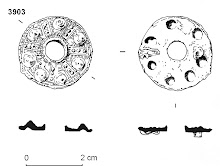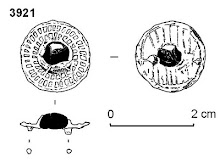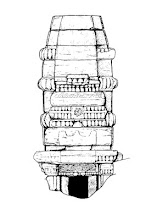One of Urban Archaeology's projects has been nominated as Current Archaeology Rescue Archaeology Project of the Year!!! I am absolutely thrilled that the hard work of all the project team has been recognised in this celebration of the best of archaeology, well done everyone!
A 12th century chapel, a 14th century Infirmarer’s Lodging with its own chapel, a 15th century kitchen (complete with suckling pig), apotropeic graffiti, some lush 18th and 19th century wallpapers, and so much more... Dulverton House was a site and a half, in the shadow of Gloucester Cathedral and involving excavation, building recording, dendrochronology, documentary research and artefact and environmental archaeology.
After the site work finished, the painstaking analysis work started, teasing out the fascinating story of the site as it developed through the centuries. I'm currently editing an academic paper focusing on the medieval phases, and there will be a short paper on a stone lamp in the next issue of Medieval archaeology. I've been privileged to work with some great teams on some great projects and this one is right up there.
There's a fantastic group of projects nominated this year, the vote is open to everyone, and voting is open now. Follow the link to read the nominations, have a read of our article in Current Archaeology Magazine, and vote!
-----------------
Refurbishment for The King's School during Lockdown transformed this
building into a new Sixth Form centre, but its origins lie many
centuries ago.
Archaeological
recording and excavation demonstrated that parts of the south wall of
the 11th century chapel of St Bridget survived within the building, and
that the primary phase of the Infirmarer's Lodging dates to the early
14th century, with dendrochronology dates by HLF funded Gloucester
Dendrochronology Project. The Lodging consisted of a two storey
building, with cross-wings housing a chapel, and a guest chamber. A late
15th century kitchen extension yielded important evidence of the use of
fish, bird and small mammals in the monastic diet.
 |
Plan of the primary early 14th century phase of the Infirmarer's Lodging showing the intimate relationship to St Bridget's chapel and the Infirmary Hall of St Peter's abbey |
 |
Early 14th century carved oak bracket in the main undercroft. It was mutilated in the Reformation or 17th century |
 |
Longitudinal cross-section of the early 14th century Lodging |
After
Dissolution the building, which had developed into a complex of wings
and extensions, housed a Prebend (canon) of the new cathedral, before
becoming part of King's school in the 1950s, with the fabric of the
building providing much evidence for the changing use and interior
decoration of the building.
 |
Late 18th century silk-effect wallpaper preserved behind a later skirting board. A glimpse of internal decoration surviving later woodchip! |















